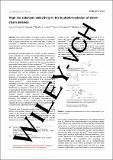High iso aldehyde selectivity in the hydroformylation of short-chain alkenes
Abstract
The hydroformylation of propene to give predominantly iso‐butanal has been achieved; class‐leading selectivity is possible even at higher temperatures that deliver fast conversion. Racemic rhodium complexes of bidentate phospholane phosphites derived from tropos‐biphenols and unusual solvent systems are the key to the selectivity observed.
Citation
Iu , L , Fuentes , J A , Janka , M , Fontenot , K J & Clarke , M L 2019 , ' High iso aldehyde selectivity in the hydroformylation of short-chain alkenes ' , Angewandte Chemie International Edition , vol. 58 , no. 7 , pp. 2120-2124 . https://doi.org/10.1002/anie.201811888
Publication
Angewandte Chemie International Edition
Status
Peer reviewed
ISSN
1433-7851Type
Journal article
Description
The authors thank the Eastman Chemical Company for funding (LI, and later JAF) and permission to publish. The EPSRC (EP/M003868/1) is also acknowledged for funding (JAF).Collections
Items in the St Andrews Research Repository are protected by copyright, with all rights reserved, unless otherwise indicated.

